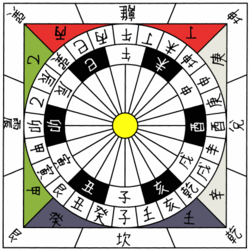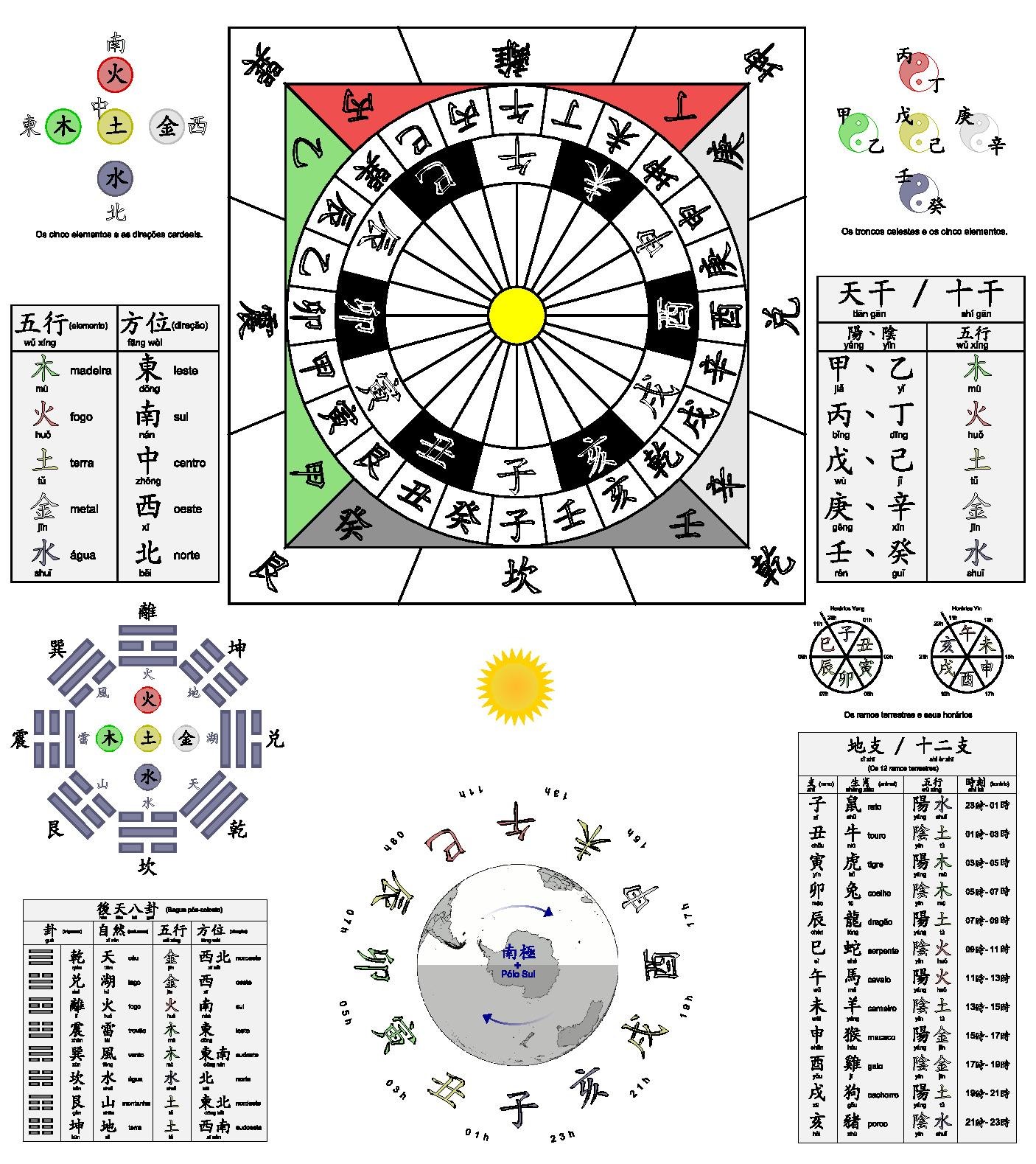Earthly Branches: Difference between revisions
m updating links using AWB |
No edit summary |
||
| Line 14: | Line 14: | ||
!Earthly <br> Branch |
!Earthly <br> Branch |
||
!Chinese <br> name |
!Chinese <br> name |
||
!Turkish <br> name |
|||
!Japanese <br> name (On and Kun) |
!Japanese <br> name (On and Kun) |
||
!Korean <br> name |
!Korean <br> name |
||
| Line 24: | Line 25: | ||
|-tr align="center" |
|-tr align="center" |
||
||1 |
||1 |
||
||子||zǐ||shi<br> ne||자 (ja) |
||子||zǐ||sıçgan-fare (rat)||shi<br> ne||자 (ja) |
||
||tý (Tí)||[[Rat (zodiac)|Rat]] |
||tý (Tí)||[[Rat (zodiac)|Rat]] |
||
||0°<br>(north)||rowspan="2"|winter||Month 11<br>([[Dongzhi|winter solstice]])||11pm to 1am<br>(midnight) |
||0°<br>(north)||rowspan="2"|winter||Month 11<br>([[Dongzhi|winter solstice]])||11pm to 1am<br>(midnight) |
||
|-tr align="center" |
|-tr align="center" |
||
||2 |
||2 |
||
||丑||chǒu||chū<br>ushi||축 (chuk)||sửu |
||丑||chǒu||ud sığır-sığır (ox)||chū<br>ushi||축 (chuk)||sửu |
||
||[[Ox (zodiac)|Ox]] |
||[[Ox (zodiac)|Ox]] |
||
||30°||Month 12||1am to 3am |
||30°||Month 12||1am to 3am |
||
|-tr align="center" |
|-tr align="center" |
||
||3 |
||3 |
||
||寅||yín||in<br>tora||인 (in) |
||寅||yín||bars-pars (panther)||in<br>tora||인 (in) |
||
||dần||[[Tiger (zodiac)|Tiger]] |
||dần||[[Tiger (zodiac)|Tiger]] |
||
||60°||td rowspan="3"|spring||Month 1||3am to 5am |
||60°||td rowspan="3"|spring||Month 1||3am to 5am |
||
|-tr align="center" |
|-tr align="center" |
||
||4 |
||4 |
||
||卯||mǎo||bō<br>u||묘 (myo) |
||卯||mǎo||tavışgan-tavşan (rabbit)||bō<br>u||묘 (myo) |
||
||mão (mẹo)||[[Rabbit (zodiac)|Rabbit]] |
||mão (mẹo)||[[Rabbit (zodiac)|Rabbit]] |
||
||90°<br>(east)||Month 2<br>([[vernal equinox]])||5am to 7am |
||90°<br>(east)||Month 2<br>([[vernal equinox]])||5am to 7am |
||
| Line 46: | Line 47: | ||
|-tr align="center" |
|-tr align="center" |
||
||5 |
||5 |
||
||辰||chén||shin<br>tatsu||진 (jin) |
||辰||chén||lu-ejder (dragon)||shin<br>tatsu||진 (jin) |
||
||thìn||[[Dragon (zodiac)|Dragon]] |
||thìn||[[Dragon (zodiac)|Dragon]] |
||
||120°||Month 3||7am to 9 am |
||120°||Month 3||7am to 9 am |
||
| Line 53: | Line 54: | ||
|-tr align="center" |
|-tr align="center" |
||
||6 |
||6 |
||
||巳||sì||shi<br>mi||사 (sa) |
||巳||sì||ılan-yılan (snake)||shi<br>mi||사 (sa) |
||
||tỵ||[[Snake (zodiac)|Snake]] |
||tỵ||[[Snake (zodiac)|Snake]] |
||
||150°||td rowspan="3"|summer||Month 4||9am to 11am |
||150°||td rowspan="3"|summer||Month 4||9am to 11am |
||
| Line 60: | Line 61: | ||
|-tr align="center" |
|-tr align="center" |
||
||7 |
||7 |
||
||午||wǔ||go<br>uma||오 (o) |
||午||wǔ||yunt-at (horse)||go<br>uma||오 (o) |
||
||ngọ||[[Horse (zodiac)|Horse]] |
||ngọ||[[Horse (zodiac)|Horse]] |
||
||180°<br>(south)||Month 5<br>([[Xiazhi|summer solstice]])||11am to 1pm<br>(noon) |
||180°<br>(south)||Month 5<br>([[Xiazhi|summer solstice]])||11am to 1pm<br>(noon) |
||
| Line 67: | Line 68: | ||
|-tr align="center" |
|-tr align="center" |
||
||8 |
||8 |
||
||未||wèi||bi<br>hitsuji||미 (mi) |
||未||wèi||koy-koyun (sheep)||bi<br>hitsuji||미 (mi) |
||
||mùi||[[Sheep (zodiac)|Sheep]] |
||mùi||[[Sheep (zodiac)|Sheep]] |
||
||210°||Month 6||1pm to 3pm |
||210°||Month 6||1pm to 3pm |
||
| Line 73: | Line 74: | ||
|-tr align="center" |
|-tr align="center" |
||
||9 |
||9 |
||
||申||shēn||shin<br>saru||신 (sin) |
||申||shēn||biçin-maymun (monkey)||shin<br>saru||신 (sin) |
||
||thân||[[Monkey (zodiac)|Monkey]] |
||thân||[[Monkey (zodiac)|Monkey]] |
||
||240°||td rowspan="3"|autumn||Month 7||3pm to 5pm |
||240°||td rowspan="3"|autumn||Month 7||3pm to 5pm |
||
| Line 80: | Line 81: | ||
|-tr align="center" |
|-tr align="center" |
||
||10 |
||10 |
||
||酉||yǒu||yū<br>tori||유 (yu) |
||酉||yǒu||taguk-tavuk (chicken)||(yū<br>tori||유 (yu) |
||
||dậu||[[Rooster (zodiac)|Rooster]] |
||dậu||[[Rooster (zodiac)|Rooster]] |
||
||270°<br>(west)||Month 8<br>([[autumnal equinox]])||5pm to 7pm |
||270°<br>(west)||Month 8<br>([[autumnal equinox]])||5pm to 7pm |
||
| Line 87: | Line 88: | ||
|-tr align="center" |
|-tr align="center" |
||
||11 |
||11 |
||
||戌||xū||jutsu<br>inu||술 (sul) |
||戌||xū||it-köpek (dog)||jutsu<br>inu||술 (sul) |
||
||tuất||[[Dog (zodiac)|Dog]] |
||tuất||[[Dog (zodiac)|Dog]] |
||
||300°||Month 9||7pm to 9pm |
||300°||Month 9||7pm to 9pm |
||
| Line 94: | Line 95: | ||
|-tr align="center" |
|-tr align="center" |
||
||12 |
||12 |
||
||亥||hài||gai<br>i||해 (hae) |
||亥||hài||tonguz-domuz (hog)||gai<br>i||해 (hae) |
||
||hợi||[[Pig (zodiac)|Pig]] |
||hợi||[[Pig (zodiac)|Pig]] |
||
||330°||winter||Month 10||9pm to 11pm |
||330°||winter||Month 10||9pm to 11pm |
||
Revision as of 21:44, 30 March 2008
The Earthly Branches (Chinese: 地支; pinyin: dìzhī; or Chinese: 十二支; pinyin: shíèrzhī; lit. 'twelve branches') provide one Chinese system for reckoning time.
This system was built from observations of the orbit of Jupiter. Chinese astronomers divided the celestial circle into 12 sections to follow the orbit of 歳星 Suìxīng (Jupiter, the Year Star). Astronomers rounded the orbit of Suixing to 12 years (from 11.86). Suixing was associated with Sheti (ɳ Böotes) and sometimes called Sheti.
In correlative thinking, the twelve years of the Jupiter cycle also identify the twelve months of the year, twelve animals (mnemonics for the system), directions, seasons, months, and Chinese hour in the form of double-hours. When a Branch is used for a double hour, the listed periods are meant. When used for an exact time of a day, it is the center of the period. For instance, 午 (the Horse) means noon or a period from 11am to 1pm. (The jie qi system provided single hours and 15-degree arcs in time and space.)
Chinese seasons are based on observations of the sun and stars, not the weather. Many Chinese calendrical systems have started the new year on the first new moon after the winter solstice.
The Earthly Branches are today used with the Heavenly Stems in the current version of the "traditional calendar" and in Taoism. The Ganzhi (Stem-Branch) combination is a fairly new way to mark time; in the Shang era it was the ten Heavenly Stems that provided the names of the days of the week. The Branches are as old as the Stems (and according to recent archaeology may actually be older), but the Stems were tied to the ritual calendars of Chinese kings. They were not part of the calendrical systems of the majority of Chinese.
| Earthly Branch |
Chinese name |
Turkish name |
Japanese name (On and Kun) |
Korean name |
Vietnamese name |
Chinese zodiac |
Direction | Season | Lunar Month | Double Hour | |
|---|---|---|---|---|---|---|---|---|---|---|---|
| 1 | 子 | zǐ | sıçgan-fare (rat) | shi ne |
자 (ja) | tý (Tí) | Rat | 0° (north) |
winter | Month 11 (winter solstice) |
11pm to 1am (midnight) |
| 2 | 丑 | chǒu | ud sığır-sığır (ox) | chū ushi |
축 (chuk) | sửu | Ox | 30° | Month 12 | 1am to 3am | |
| 3 | 寅 | yín | bars-pars (panther) | in tora |
인 (in) | dần | Tiger | 60° | spring | Month 1 | 3am to 5am |
| 4 | 卯 | mǎo | tavışgan-tavşan (rabbit) | bō u |
묘 (myo) | mão (mẹo) | Rabbit | 90° (east) |
Month 2 (vernal equinox) |
5am to 7am
| |
| 5 | 辰 | chén | lu-ejder (dragon) | shin tatsu |
진 (jin) | thìn | Dragon | 120° | Month 3 | 7am to 9 am
| |
| 6 | 巳 | sì | ılan-yılan (snake) | shi mi |
사 (sa) | tỵ | Snake | 150° | summer | Month 4 | 9am to 11am
|
| 7 | 午 | wǔ | yunt-at (horse) | go uma |
오 (o) | ngọ | Horse | 180° (south) |
Month 5 (summer solstice) |
11am to 1pm (noon)
| |
| 8 | 未 | wèi | koy-koyun (sheep) | bi hitsuji |
미 (mi) | mùi | Sheep | 210° | Month 6 | 1pm to 3pm | |
| 9 | 申 | shēn | biçin-maymun (monkey) | shin saru |
신 (sin) | thân | Monkey | 240° | autumn | Month 7 | 3pm to 5pm
|
| 10 | 酉 | yǒu | taguk-tavuk (chicken) | (yū tori |
유 (yu) | dậu | Rooster | 270° (west) |
Month 8 (autumnal equinox) |
5pm to 7pm
| |
| 11 | 戌 | xū | it-köpek (dog) | jutsu inu |
술 (sul) | tuất | Dog | 300° | Month 9 | 7pm to 9pm
| |
| 12 | 亥 | hài | tonguz-domuz (hog) | gai i |
해 (hae) | hợi | Pig | 330° | winter | Month 10 | 9pm to 11pm |
Some cultures assign different animals: Vietnam replaces the ox, rabbit, and sheep with the water buffalo, cat, and goat respectively; Japan replaces the pig with the wild boar.
Directions

Even though Chinese has words for the four cardinal directions - 北 (běi, north), 東 (dōng, east), 南 (nán, south), and 西 (xī, west) - Chinese mariners and astronomers/astrologers preferred using the twelve directions of the Earthly Branches, which is somewhat similar to the modern-day practice of English-speaking pilots using o'clock for directions. Since twelve points were not enough for sailing, twelve midpoints were added. Instead of combining two adjacent direction names, they assigned new names as follows:
- For the four diagonal directions, appropriate trigram names of I Ching were used.
- For the rest, the Heavenly Stems were used. According to the Five Elements theory, east is assigned to wood, and the Stems of wood are 甲 (jiǎ) and 乙 (yǐ). Thus they were assigned clockwise to the two adjacent points of the east.
Following is a table of the 24 directions:
|
|
Advanced mariners such as Zhèng Hé used 48-point compasses. An additional midpoint was called by a combination of its two closest basic directions, such as 丙午 (bǐngwǔ) for the direction of 172.5°, the midpoint between 丙 (bǐng), 165°, and 午 (wǔ), 180°.
See also
- Sexagesimal cycle (干支)
- Chinese calendar
 (A study of the cardinal directions chart)
(A study of the cardinal directions chart)


